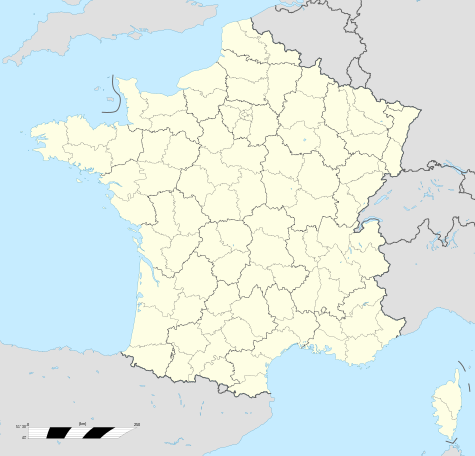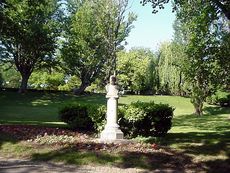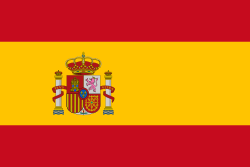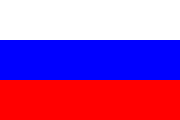Béziers
|
Béziers |
|
 |
|
| St. Nazaire Cathedral and Pont Vieux | |
 Béziers
|
|
| Administration | |
|---|---|
| Country | France |
| Region | Languedoc-Roussillon |
| Department | Hérault |
| Arrondissement | Béziers |
| Intercommunality | Béziers Méditerranée |
| Mayor | Raymond Couderc (UMP) (2008-2014) |
| Statistics | |
| Elevation | 4–120 m (13–390 ft) (avg. 17 m/56 ft) |
| Land area1 | 95.48 km2 (36.87 sq mi) |
| Population2 | 69,153 (1999) |
| - Density | 724 /km2 (1,880 /sq mi) |
| INSEE/Postal code | 340032/ 34500 |
| 1 French Land Register data, which excludes lakes, ponds, glaciers > 1 km² (0.386 sq mi or 247 acres) and river estuaries. | |
| 2 Population sans doubles comptes: residents of multiple communes (e.g., students and military personnel) only counted once. | |
Béziers (Occitan: Besièrs) is a town in Languedoc in the southwest of France. It is a commune and a sub-prefecture of the Hérault department.[1] Béziers hosts the famous Feria de Béziers, centred around bullfighting, every August. A million visitors are attracted to the five-day event.[2]
Inhabitants of Béziers are known as Biterrois (male) or Biterroises (female), after Baeterrae, the Roman name for the town.
Contents |
Geography
The town is located on a small bluff above the river Orb, about 10 km (6.2 mi) from the Mediterranean Sea. At Béziers the Canal du Midi spans the river Orb as an aqueduct called the Pont-canal de l'Orb. claimed to be the first of its kind.[3]
History
The site has been occupied since Neolithic times, before the influx of Celts. Roman Betarra was on the road that linked Provence with Iberia. The Romans refounded the city as a new colonia for veterans in 36/35 BC and called it Colonia Julia Baeterrae Septimanorum. Stones from the Roman amphitheatre were used to construct the city wall during the 3rd century.
White wine was exported to Rome; two dolia discovered in an excavation near Rome are marked, one "I am a wine from Baeterrae and I am five years old," the other simply "white wine of Baeterrae". She was occupied by Moors between 720 and 752.
During the 10th through 12th centuries Béziers was the centre of a Viscountship of Béziers. The viscounts ruled most of the coastal plain around the city, including also the city of Agde. They also controlled the major east-west route through Languedoc, roughly following the old Roman Via Domitia, with the two key bridges over the Orb at Béziers and over the Hérault at Saint-Thibéry.
After the death of viscount William around 990, the viscounty passed to his daughter Garsendis and her husband, count Raimond-Roger of Carcassonne (d. ~1012). It was then ruled by their son Peter-Raimond (d. ~1060) and his son Roger (d. 1067), both of whom were also counts of Carcassonne.
Roger died without children and Béziers passed to his sister Ermengard and her husband Raimond-Bertrand Trencavel. The Trencavels were to rule for the next 142 years, until the Albigensian Crusade - a formal 'Crusade' (holy war) authorised by Pope Innocent III.
Béziers was a Languedoc stronghold of Catharism, which the Catholic Church condemned as heretical and which Catholic forces extirpated in the Albigensian Crusade. Béziers was sacked on 22 July 1209. Béziers' Catholics were given the opportunity to leave before the Crusaders besieged the city. However, they refused and fought with the Cathars. In a sortie outside the walls, their combined force was defeated, and pursued back into town. In the bloody massacre which followed, no one was spared, not even those who took refuge in the churches. One of the commanders of the crusade was the Papal Legate Arnaud-Amaury (or Arnald Amalaricus, Abbot of Citeaux). When asked by a Crusader how to tell Catholics from Cathars once they had taken the city, the abbot supposedly replied, "Kill them all, God will know His own" - "Neca eos omnes. Deus suos agnoscet". (This often quoted phrase is sourced from Caesarius of Heisterbach along with a story of some Cathars who desecrated a copy of the Old Testament and threw it from the town's walls.)
The invaders burned the cathedral of Saint Nazaire, which collapsed on those who had taken refuge inside. The town was pillaged and burnt. None were left alive. (A plaque opposite the cathedral records the 'Day of Butchery' perpetrated by the 'northern barons'.) A few parts of the Romanesque cathedral St-Nazaire survived, and repairs started in 1215. The restoration, along with that of the rest of the city, continued until the 15th century.
In the repression following Louis Napoléon's coup d'état in 1851, troops fired on and killed Republican protestors in Béziers. Others were condemned to death or transported to Guiana, including a former mayor who died at sea attempting to escape from there. In the Place de la Révolution a plaque and a monument by Jean Antoine Injalbert commemorates these events. (Injalbert also designed the Fontaine du Titan in Béziers' Plâteau des Poètes park and the Molière monument in nearby Pézenas.)
Ecclesiastical history
Local traditions had St. Aphrodisius arrive at Béziers mounted on a camel. Hence the custom of leading a mechanical camel in the procession at Béziers on the feast of the saint. The camel was burned during the Wars of Religion and again during the French Revolution. The custom was revived in 1803 only to be discontinued during the Revolution of 1830, when it was considered a symbol of feudalism and religious fanaticism. Today, it continues to run through the city's streets during local holidays. The current head dates from the eighteenth century. In the 1970s, it was proposed that the camel be remade to give it a real camel's appearance. However, the townspeople protested and the camel retained its traditional appearance.[4]
The first historically known bishop is Paulinus mentioned in 418; St. Guiraud was Bishop of Béziers from 1121 to 1123.
- Massacre, 1209
Various sources (including a letter by Arnaud Amaury to Pope Innocent III) state that the population of the town in 1209 was nearly twenty thousand and none were spared when the Crusaders, led by Simon de Montfort, stormed the defences. Several thousand men, women and children sought refuge in the Eglise de la Madeleine and all were slaughtered. Poignantly, the massacre took place on 22 July 1209 (Ste. Madeleine's Day - the feast of Mary Magdalene).
Several thousand others took refuge in the Cathedral of St Nazaire but this was set alight by the Crusaders and almost completely destroyed; none survived.
Economy
Today Béziers is a principal centre of the Languedoc viticulture and winemaking industries.
Transport
The A9 autoroute skirts Béziers. The final link in the A75 autoroute between Pezenas and the A9 will be completed by spring 2011 and provide direct links to Clermont-Ferrand and Paris.
The Gare de Béziers is a train station offering connections to Toulouse, Montpellier, Marseille, Paris, Barcelona and seevral regional destinations.
Béziers Cap d'Agde Airport (previously Béziers-Agde-Vias Airport), owned by the Chamber of Commerce and Industry, currently provides daily direct flights to Paris Orly and seasonal services to Bastia. Following an extension to the runway which was completed in March 2007, Ryanair began flights to and from Bristol International Airport in March 2008, and later to London Stansted and London Luton Airport.[5] Danish airline, Cimber Air has started a summer service to Odense.
Culture
Sport
Béziers fields a rugby union team (AS Béziers) with twelve championships to their credit.
Béziers also hosts Languedocian sea jousts in the summer.
Monuments and sites

- Saint-Nazaire Cathedral : Situated in the high part of town, it occupies a picturesque site, visible from afar when approaching Béziers on the road from Narbonne. A remarkable example of middle Gothic architecture from the 14th century, the vaulted nave, 14 m (45.93 ft) wide, reach a height of 32 m (104.99 ft). The total length is 50 m (164.04 ft). The western rose window has a diameter of 10 m (32.81 ft).
- The Plateau des Poètes (1867) : This vast English style (formal) park was laid out by landscape artists, the Bullher brothers. It contains numerous statues of poets and a monumental fountain of the Titan by Injalbert. The park connects the station with the allées Paul Riquet where a large bronze statue by David d'Angers celebrates the creator of the Canal du Midi, Pierre-Paul Riquet. The same sculptor created the bas reliefs which decorate the neo-Classical façade of the Municipal Theatre (1844) at the top of the allées.
- Arenas : Béziers has two arenas, one dating from the Roman era whose structures and foundations have been preserved following major works in the Saint-Jacques district, and the other built in 1905 in the style of Spanish bullrings by Fernand Castelbon de Beauxhostes. The latter is one of the largest such structures in France (13100 places). The arena hosts concerts and, every August, a bullfighting festival (the Féria).
- The Fine Arts Museum (musée des Beaux-Arts), founded in 1859, received in 1934 the legacy of Injalbert's widow and, in 1975, drawings and the art collection of Jean Moulin. Among the museum's works are canvasses by Hans Holbein, Sebastien Bourdon, Géricault, Vincent van Gogh, Chaïm Soutine and Henri Goetz.
- The musée Saint-Jacques, installed in a former barracks, has collections showing life in the Béziers region (Biterrois).
- Le Pont Vieux is a stone bridge crossing the Orb (Middles Ages).
- Le Cimetière Vieux (Old Cemetery), crated in the 18th century, is a veritable open-air museum with numerous tombs and works of art by local sculptors, including Jean Magrou and Injalbert.
Other sites and monuments :
- The Canal du Midi (17th century) :
- The canal bridge
- The Fonserannes locks
- Garden de la Plantade
- The Cordier or Bagnols mill
- Saint-Jacques Church
- The Saint-Aphrodise Church
- Church of the Madeleine
- Saint Jude Church
- Church of the Immaculate Conception and its glazed tile roof
- The Capnau quarter
- Isalnd of Tabarka, on the Orb
- The Municipal Theatre (19th century)
- The Art Nouveau former Théâtre des Variétés
- The market hall (end of 19th century)
- The Saint-Jean-d'Aureilhan estate
- The Domaine de Bayssan
- Chapelle du Jardin Notre-Dame (18th century)
- Chapelle des Pénitents Bleus (18th century)
- Some churches in Béziers
|
The Cathédrale Saint-Nazaire with the église Saint-Jude below |
 L'église de la Madeleine |
Basilique Saint-Aphrodise |
Chapelle des Pénitents |
|
Eglise de l'Immaculée-Conception |
Eglise de la Sainte-Famille |
Eglise Saint-Jacques |
Eglise Bon Pasteur |
In the region:
- The Oppidum d'Ensérune is an important archaeological site.
- The Étang de Montady, a marsh drained in 1247, is a field and irrigation system which is visible from the Oppidum d'Ensérune.
Notable people
Béziers was the birthplace of:
- Jedaiah ben Abraham Bedersi (1270–1340), poet, philosopher and physician
- Pierre Paul Riquet (1609 or 1604–1680), engineer and canal-builder responsible for the construction of the Canal du Midi
- Paul Pellisson (1624–1693), author
- Jean Barbeyrac (1674?-1744), jurist
- Jean-Jacques d'Ortous de Mairan (1678–1771), geophysicist
- Pierre Jean Porro (1750–1831), guitarist, composer and music publisher
- Joseph-Henri baron de Jessé (1755–1794), nobleman and president of the National Constituent Assembly
- Jean Antoine Ernest Constans (1833–1913), statesman
- Jean Antoine Injalbert (1845–1933), sculptor
- Henri Fescourt (1880–1946), film director
- Aurélie Kamga, athlete
- Jean Moulin (1899–1943), a hero of the French Resistance in World War II
- Edgar Faure (1908–1988), French statesman
- Alexandra Rosenfeld, Miss France 2006, Miss Europe 2006
- Julien Rodriguez, Olympique de Marseille footballer
- Jérémy Clément, Paris Saint-Germain footballer
- Richard Gasquet, French tennis player
Cultural references
- The Kate Mosse novel Labyrinth, a work of fiction, draws on the history of Carcassonne, Béziers and the Cathars.
Twin towns
Béziers is twinned with:
 Chiclana in Spain (since 1993)
Chiclana in Spain (since 1993) Heilbronn in Germany (since 1965)
Heilbronn in Germany (since 1965) Stavropol in Russia (since 1982)
Stavropol in Russia (since 1982) Stockport in United Kingdom (since 1972)
Stockport in United Kingdom (since 1972)
See also
- Occitania
- Septimania
- Guillaume Bottazzi, painted a mural, "Les Muriers Blancs", on eight faces of two buildings in Béziers
References
Notes
- ↑ The Green Guide Languedoc Roussillon Tarn Gorges - Michelin Travel Publications 2007
- ↑ Beziers Tourist Site
- ↑ Beyond.fr Tourist Site
- ↑ Histoire de BИziers. "Lou Camel". Sunnyfrance.net. http://www.sunnyfrance.net/histoiredebeziers/camel_UK.htm. Retrieved 2009-05-05.
- ↑ Midi Libre, 24 March 2008
External links
- Official tourist office website for visiting Béziers (In English)
- Official website city of Beziers.
- Photos "Festa d'Oc
- History of Beziers
- Béziers Congrès
 This article incorporates text from a publication now in the public domain: Herbermann, Charles, ed (1913). Catholic Encyclopedia. Robert Appleton Company.
This article incorporates text from a publication now in the public domain: Herbermann, Charles, ed (1913). Catholic Encyclopedia. Robert Appleton Company.
|
|||||